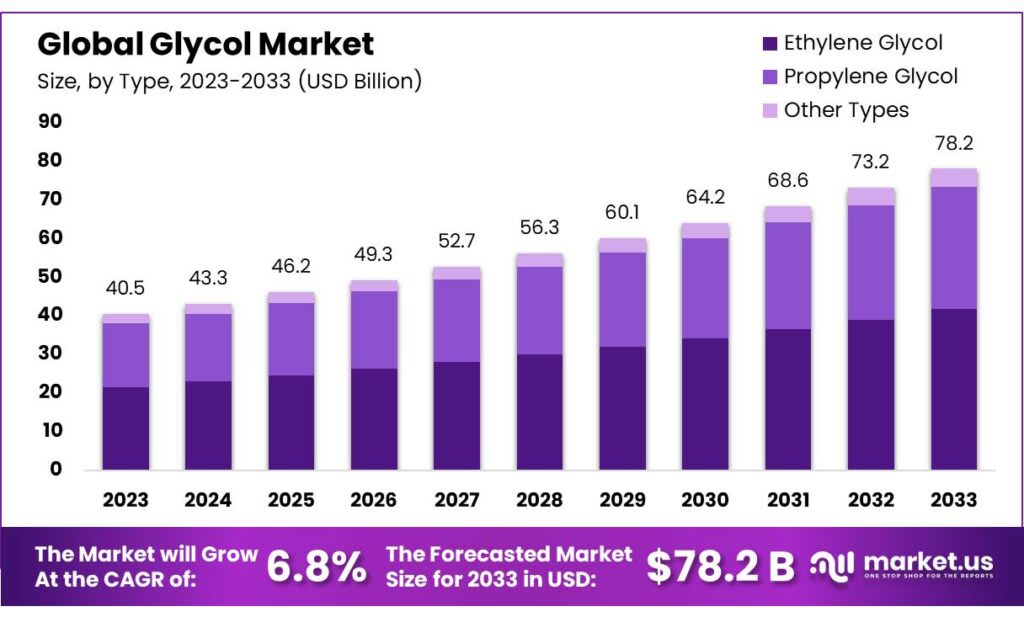Health Concerns Pose Challenges for Glycol Market Growth
Glycol Market size is expected to be worth around USD 78.2 billion by 2033, from USD 40.5 Bn in 2023, growing at a CAGR of 6.8%

Overview
Glycol Market size is expected to be worth around USD 78.2 billion by 2033, from USD 40.5 Bn in 2023, growing at a CAGR of 6.8% during the forecast period from 2023 to 2033.
The glycol market revolves around the production, distribution, and use of various types of glycol, which are organic compounds belonging to the alcohol family. The most common types include ethylene glycol and propylene glycol. Ethylene glycol is primarily used as an antifreeze in automotive cooling systems and in the manufacturing of polyester fibers and resins. Propylene glycol, on the other hand, is utilized in a broader range of applications due to its lower toxicity, making it suitable for use in food, pharmaceuticals, and cosmetics, as well as in industrial applications like antifreeze and de-icing solutions.
The growth of the glycol market is driven by its versatile applications across multiple industries. In the automotive sector, the increasing demand for vehicles boosts the need for antifreeze and coolant products, thereby driving the demand for ethylene glycol. Similarly, the expanding textile and packaging industries are major consumers of polyester resins, which rely on glycol compounds. Propylene glycol’s use in personal care products and food additives is bolstered by growing consumer awareness and demand for safer, non-toxic products.
However, the market faces challenges such as fluctuating raw material prices and environmental concerns related to the production and disposal of glycols. Innovations in green chemistry and sustainable production methods are crucial for addressing these challenges and ensuring the continued growth of the glycol market.
Кеу Маrkеt Ѕеgmеntѕ
By Type
Ethylene Glycol
Monoethylene Glycol (MEG)
Diethylene Glycol (DEG)
Triethylene Glycol (TEG)
Propylene Glycol
End-user Industry
Automotive
Auto Retail
Auto Traditional
Heavy-duty
Specialty Applications
HVAC
Textiles
Airlines
Medical
Pipeline Maintenance
Polyester Fibers & Resins
Food & Beverage
Other Applications
Download a sample report in MINUTES@ https://market.us/report/glycol-market/request-sample/
In 2023, Ethylene Glycol dominated the glycol market with a 53.4% share, driven by its versatile applications across various industries. The Automotive and Transportation sector led the glycol market, accounting for 35.6% of the demand, primarily for its use as an antifreeze agent in automotive coolants.
Маrkеt Кеу Рlауеrѕ
DowDuPont
Shell PLC
MEGlobal International FZE
Indorama Ventures Public Company Limited
Reliance Industries Limited
PETRONAS Chemicals Group
BASF
Sinopec
Royal Dutch Shell
Lotte Chemical
Ashland
Cargill
Univar
AkzoNobel
SABIC
Huntsman
Others
Drivers: The glycol market is driven by the growing reliance of the textile industry on glycols, especially ethylene glycol, for producing essential materials like polyester fibers, cellophane, and leather. Post-pandemic, countries like China, the EU, and India saw significant growth in textile production and exports, with India benefiting from government initiatives like mega textile parks and the Buy America Act waiver procedure, further boosting market growth.
Restraints: Health concerns related to excessive glycol consumption, which can pose significant health risks, are a major restraint. Regulatory guidelines, such as the WHO's limit of 25 mg/kg of body weight for daily glycol intake as a food additive, aim to ensure safety. These concerns necessitate consumer education and adherence to safety guidelines to mitigate the impact on market growth.
Opportunities: The automotive industry's increasing reliance on ethylene glycol presents a significant growth opportunity. Ethylene glycol's properties, such as its low freezing point, make it crucial for automotive applications, including as an antifreeze and coolant. As automotive technology advances, the demand for ethylene glycol is expected to surge, driving market expansion.
Challenges: The glycol market faces challenges from health concerns, fluctuating raw material prices, and environmental regulations. Addressing these issues requires innovation, regulatory compliance, and investment in sustainable technologies. Additionally, the market's dependence on specific industries like automotive and textiles makes it vulnerable to sector-specific fluctuations, necessitating adaptive strategies for sustained growth.
About the Creator
Enjoyed the story? Support the Creator.
Subscribe for free to receive all their stories in your feed. You could also pledge your support or give them a one-off tip, letting them know you appreciate their work.





Comments
There are no comments for this story
Be the first to respond and start the conversation.